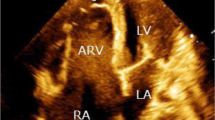Abstract
A 7-month-old asymptomatic infant was known to have a restrictive membranous ventricular septal defect partially closed by an aneurysm of the membranous septum. At 13 months of age, he developed unexpected pulmonary hypertension, with no clinical sign of cardiac failure. Cardiac catheterization assessed the pulmonary artery pressure at a systemic level with significant left-to-right shunt. After surgical closure, the pulmonary arterial pressure decreased by 50%. We suspect an enlargement of the ventricular septal defect caused by the rupture of the aneurysm of the membranous septum—a rare complication.



Similar content being viewed by others
References
Beerman LB, Park SC, Fischer DR, et al. (1985) Ventricular septal defect associated with aneurysm of the membranous septum. J Am Coll Cardiol. 5:118–123
Campbell M (1971) Natural history of ventricular septal defect. Br Heart J 33:246–257
Chantepie A, Luksemberg S, Vaillant MC, et al. (1999) Evolution of ventricular septal defects. Relation to echocardiographic anatomy. Arch Mal Coeur 92:623–628
Corone P, Doyon F, Gaudeau S, et al. (1979) Natural history of ventricular defects : ten-years follow-up. Pediatrics 63:204–206
Gabriel HM, Heger M, Innerhofer P, et al. (2002) Long-term outcome of patients with ventricular septal defect considered not to require surgical closure during childhood. J Am Coll Cardiol 39:1066–1071
Ito T, Okubo T, Kimura M, Ito S, Akabane J (2001) Increase in diameter of ventricular septal defect and membranous septal aneurysm formation during the infantile period. Pediatr Cardiol. 22:491–493
Keith JD, Rose V, Collins G, Kidd BS (1971) Ventricular septal defect. Incidence, morbidity, and mortality in various age groups. Br Heart J 33:81–87
Ramaciotti C, Keren A, Silverman NH (1986) Importance of (perimembranous) ventricular septal aneurysm in the natural history of isolated perimembranous ventricular septal defect. Am J Cardiol. 57:268–272
Vaillant MC, Chantepie A, Cheliakine C, Nashashibi M, Pottier JM, Laugier J. (1992) Contribution of two-dimensional echography in predicting spontaneous closure of interventricular defects in infants. Arch Mal Coeur 85:597–601
Yilmaz AT, Özal E, Arslan M, Tatar H, Öztürk OY (1997) Aneurysm of the membranous septum in adult patients with perimembranous ventricular sepatl defect. Eur J Cardiothorac Surg. 11:307–311
Author information
Authors and Affiliations
Corresponding author
Rights and permissions
About this article
Cite this article
Legendre, A., Bergoend, É., Vaillant, M.C. et al. Unusual Hemodynamic Changes in an Infant with a Restrictive Ventricular Septal Defect. Pediatr Cardiol 29, 166–168 (2008). https://doi.org/10.1007/s00246-007-9075-1
Received:
Revised:
Accepted:
Published:
Issue Date:
DOI: https://doi.org/10.1007/s00246-007-9075-1




